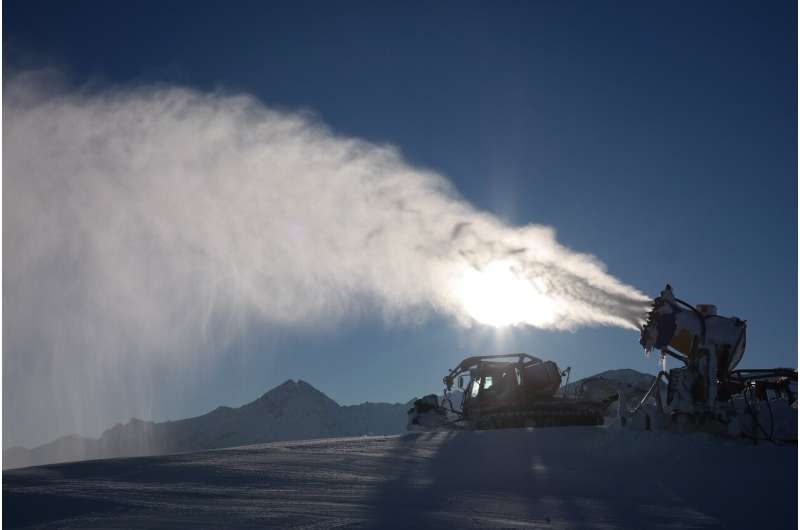Experts uncover the water and emissions footprint of snowmaking: Can we rely on it in an era of climate change?

The first-ever national study to assess the impact of developing artificial snow shows the pressure the process is putting on the climate, with the equivalent of nearly 17,000 homes’ worth of annual energy needed to produce snow for yearly ski operations in just Canada alone.
Publishing their findings in the journal Current Issues in Tourism, experts from the University of Waterloo, in Canada, and the University of Innsbruck, Austria, found 130,095 tons CO2e are needed to produce the estimated 42 million cubic meters of machine-made snow in Canada in an average winter. For context, this is comparable to 155,141 acres of forest for one year sequestering the comparable amount of carbon.
As more snowmaking is needed under future climate change, water and energy requirements will continue to grow even as average ski seasons get shorter in the decades ahead.
In order to make snowmaking, and indeed skiing in Canada more sustainable, the team calls for collaboration between ski operators, policymakers, and environmental organizations, and skiers to develop and support comprehensive policies and practices that “prioritize sustainability in addressing the challenges posed by climate change and its associated impacts on snowpack.”
“Our results emphasize the need to adopt a systems approach to ensure the long-term sustainability of ski tourism,” says co-author Professor Daniel Scott, from the Geography and Environmental Management department at Waterloo.
“This will include embracing innovation and investing in energy-efficient snowmaking technologies, promoting water conservation measures, and accelerating the transition to renewable energy sources.”
“Snowmaking can actually help reduce total emissions from tourism when it enables millions of skiers to ski regionally instead of driving or flying to far off ski resorts or selecting another type of carbon intense holiday. Net-zero compatible ski holidays are already possible in destinations like Quebec and our study shows a vibrant and resilient future for ski tourism is possible.”
Winter mountain destinations are a key part of the tourism sector in Canada. Currently there are 237 ski areas operating and hosting an average of 18.2 million skier visits, including 2.7 million international visits.
This, however, comes with implications for the long-term sustainability of ski tourism. Based on the current electrical grid carbon intensity, the team found that snowmaking in Canada uses 478,000 megawatt-hours (MWh) of electricity annually, resulting in 130,095 tons of associated CO2 emissions—and an estimated 43.4 million cubic meters of water to produce over 42 million cubic meters of technical snow.
As climate change continues to exert its impact on the snowpack in ski areas around the world, ski operators are increasingly relying on snowmaking to maintain ski seasons and provide an enjoyable experience for visitors.
In Canada, the study estimated snowmaking requirements to increase between 55% and 97% by 2050. Water and energy requirements will rise proportionally, assuming terrain coverage and average snowmaking efficiencies remain static.
However, in Canada at least, good news appears to be on the horizon which much-needed decarbonization policies, which Professor Scott says will decrease ski operations related emissions “substantially.”
“What we can see is that snowmaking emissions are expected to decline substantially, thanks to the ongoing efforts to decarbonize provincial electricity grids in alignment with current policy targets. Future emissions will also be influenced by various other factors, including upgrades in snowmaking and grooming technology and increased terrain coverage.”
The authors state, that while this research provides an essential first evaluation of the environmental impacts of snowmaking, and its potential sustainability, changes in emissions and water use will need to be reassessed alongside destination-level sustainable development as climate change accelerates and decarbonization targets are pursued.
More information:
Sustainability of Snowmaking as Climate Change (mal)Adaptation: An Assessment of Water, Energy, and Emissions in Canada’s Ski Industry, Current Issues in Tourism (2023). DOI: 10.1080/13683500.2023.2214358
Citation:
Experts uncover the water and emissions footprint of snowmaking: Can we rely on it in an era of climate change? (2023, June 7)
retrieved 7 June 2023
from https://phys.org/news/2023-06-experts-uncover-emissions-footprint-snowmaking.html
This document is subject to copyright. Apart from any fair dealing for the purpose of private study or research, no
part may be reproduced without the written permission. The content is provided for information purposes only.
For all the latest Science News Click Here
For the latest news and updates, follow us on Google News.

